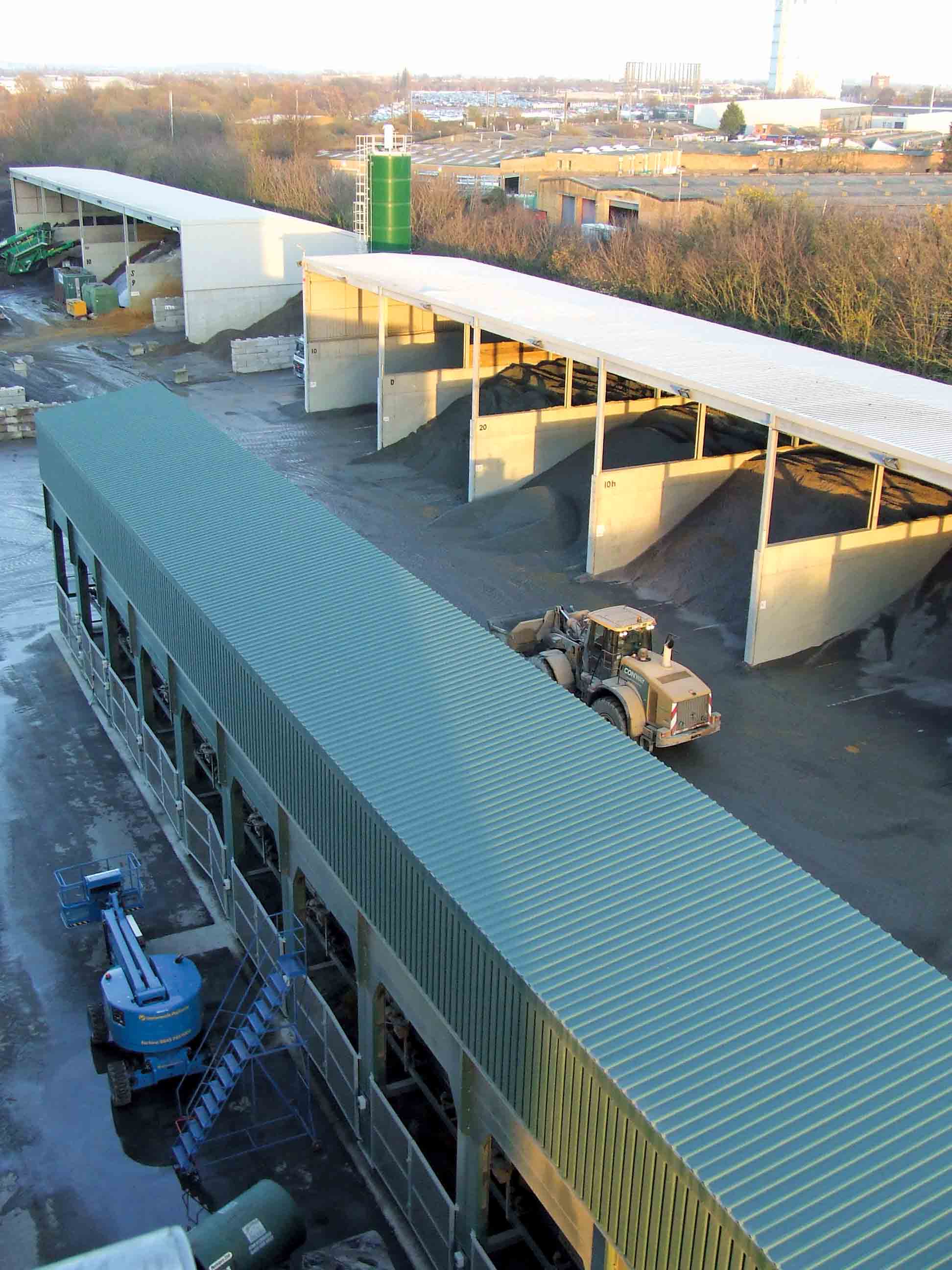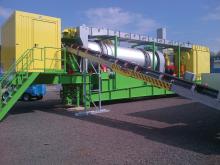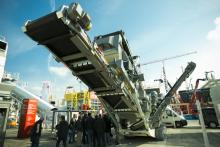Asphalt plant manufacturers agree that recycled asphalt is a valuable resource that is too good to waste - Mike Woof writes. Around the globe there is growing interest in the use of recycled asphalt pavement (RAP). The technology to utilise RAP in asphalt mixes has been available for some time, with a range of asphalt plant manufacturers in the US and Europe having developed a number of solutions. However, take-up of this technology has varied, with the US pushing ahead with the use of RAP while progress ha

Separated storage of RAP materials with weather protection can help optimise feed quality
Asphalt plant manufacturers agree that recycled asphalt is a valuable resource that is too good to waste - Mike Woof writes
Around the globe there is growing interest in the use of recycled asphalt pavement (RAP). The technology to utilise RAP in asphalt mixes has been available for some time, with a range of asphalt plant manufacturers in the US and Europe having developed a number of solutions. However, take-up of this technology has varied, with the US pushing ahead with the use of RAP while progress has been much slower in Europe. But many European countries are now becoming more aware of the need to lower the reliance on new aggregates through the use of RAP. And other markets, too, are seeing greater interest in the use of RAP, with the Chinese authorities, for example, having set requirements for this material to be used in road building.
Using RAP can lead to substantial savings in both production costs and indirect CO2 emissions. A paper by6791 Ammann’s commercial manager, Peter Maurer, highlights the fact that RAP is not a waste material but one that can be re-used efficiently. This is a key issue that all the specialists building equipment for the asphalt sector, such as 1250 Astec, 167 Benninghoven, 8346 Günter Papenburg, 246 Intrame, 1177 Lintec and 273 Marini, will agree with 6791 Ammann upon.
Both the aggregates and bitumen contained in RAP can meet the standards allowing re-use. Adding some quantities of new aggregates and bitumen can ensure that quality is maintained.
Clearly, the use of recycled asphalt pavemen (RAP) will only increase across the globe, with asphalt plant manufacturers having already developed ingenious solutions to make best use of this material.
Maurer’s paper details a number of fundamental points for the use of large quantities of RAP in an asphalt plant, which all of the key suppliers in the market segment would agree with. First, legislation must allow the use of RAP in asphalt mixes. Second, there must be a sufficient supply of the material available to a user to make the investment in the extra equipment needed worthwhile. Assuming that the material can be used and is available, the asphalt plant owner then has to provide separate storage facilities for different grades of RAP being received. Careful monitoring of the RAP supply has to be carried out, with laboratory-based testing to assess the quality. And the higher the percentage of RAP being used in the mix, the greater the importance of assuring the quality of the RAP feed.
Marzio Ferrini, head of product marketing at Marini, emphasised that determining the quality of the RAP is essential. He said that quality testing of road materials being milled off should be carried out so that the contractor knows exactly what grade is being recovered. He said, “You need to know the source of the RAP.”
Ferrini added that weather protection is also important for the RAP storage area, as this helps to reduce the moisture levels in the material, lowering the quantities of fuel used for heating the plant. This is a technical point on which Marini’s rivals are in broad agreement.
Batching-type plants are favoured by users in many markets, because of their versatility and adaptability. Modern batching plants are now often constructed in modular form with prewired components, allowing faster commissioning onsite while they can also be set up to handle a wide range of mix specifications. This versatility in construction also helps these plants to use RAP in the mix (although it is worth noting that continuous-type plants can also be configured to handle RAP).
Accurate weighing of the RAP entering the mixer is necessary to ensure that the correct quantities of materials are used, a point on which Benninghoven’s sales manager Rainer Böllinger, as well as Ferrini and Maurer all agree. The feed conveyor systems can be equipped with load scales on the belt so that the quantities can be monitored continuously.
With regard to the use of cold RAP in the mix, there is considerable discussion too as to how much can be used efficiently, however.
Böllinger said that Benninghoven’s latest granulators play a key role in the production process by breaking up the RAP prior to being used in the feed. Böllinger said, “The granulator is a key factor for high-quality recycling management. You need soft crushing to protect the stone and you remove the fines in the end products. You can increase the percentage of recycled feed in the plant by 5-10%; because you remove the fines efficiently, you don’t destroy the stone and you retain the bitumen.”
According to Böllinger, using the granulator helps recoat the bitumen around the stone and avoids the need for long mixing cycles in the mixer, with a boost to productivity. He said that the material being delivered to the mixer is more homogenous, allowing a conventional mixing cycle of 45 seconds.
Another important feature is the slow feed rate for the RAP into the mixer box, which reduces the quantity of steam being released. Ammann’s and Benninghoven’s burners are controlled by an inverter system, which it claims also helps to boost overall plant efficiency. When the plant has a low level of throughput into the drier drum, the burner reduces the fuel consumption.
Ferrini pointed out that the mix design must be modified to incorporate RAP, while the plant has to have the necessary features to accommodate this. The recipe has to be checked using software, with continual monitoring of all the feed components.
The introduction of the RAP in the feed can generate large quantities of steam from the mixer, so the Marini plants have a special tube that operates under negative pressure as an extractor.
Marini’s approach to allowing a high percentage of RAP into the mix, however, is to use a larger mixer. Because of the heat-exchange process to the cold RAP, the mixing time is typically increased to 50 seconds, compared with the 45 seconds for a conventional mix using virgin materials. Ferrini said, “If you want good quality, you need more time to heat the material and allow the bitumen to cover the stone.”
He said that a batching plant using fresh aggregates and with an output of 240tonnes/hour will typically have a 5tonne mixer and a mixing time of 45 seconds for each batch. But when cold RAP is used in the mix, extra time is required for the heat-transfer process so that the mixing time will be increased to 50 seconds, so to ensure the output remains the same at 240tonnes/hour, the mixer capacity has to be increased to 6tonnes. “The bigger batch compensates for the longer time,” he said. “The more cold RAP you use, the longer the time you need.”
Ferrini said that while higher percentages of cold RAP can be used in theory, this requires a greater energy transfer, and to prevent overheating of the material, even longer times are needed and this will increase fuel consumption significantly. “We can do this but the machine must be specifically designed for it with a big mixer and a big burner and use a very good quality RAP and with a low moisture content.”
Ferrini added that in addition to the technology used for the introduction of cold RAP directly into the mixer, the firm can help increase the percentage of RAP used. This is achieved by adding RAP into the recycling ring on the dryer drum and by combining both technologies, Ferrini said that the Marini plants can reach a recycling rate of up to 60%.
The view from Ammann is broadly in agreement with Marini. And Maurer’s paper on the use of recycled asphalt details how a feed of up to 30% of cold RAP can be fed directly into the mixer. Keeping the moisture of the RAP lower than 2% allows the percentage to go up to 35% or 40%, supported by an intelligent feed of the RAP into the mixer. The paper also highlights how, by using a parallel dryer in parallel flow technology, a feed of up to 60% of hot recycled material can be used in the mix.
However, Maurer points out that Ammann is working on technology to boost the quantity of recycled materials from the current maximum of 60% when using a dried feed, having set a target of 100%. This technology, based on the counter flow drying principle in combination with a hot gas generator, and equipped with some high sophisticated air ducting details, was introduced in 2007 in a wide range of installations. It ensures gentle drying and heating of the RAP, and in some road-construction projects it was possible to use up to 98% of RAP with this technology.
Nowadays, all of the leading manufacturers in the asphalt plant field will be working in this same direction to optimise the use of RAP, although the solutions they eventually deliver may vary significantly.
Around the globe there is growing interest in the use of recycled asphalt pavement (RAP). The technology to utilise RAP in asphalt mixes has been available for some time, with a range of asphalt plant manufacturers in the US and Europe having developed a number of solutions. However, take-up of this technology has varied, with the US pushing ahead with the use of RAP while progress has been much slower in Europe. But many European countries are now becoming more aware of the need to lower the reliance on new aggregates through the use of RAP. And other markets, too, are seeing greater interest in the use of RAP, with the Chinese authorities, for example, having set requirements for this material to be used in road building.
Using RAP can lead to substantial savings in both production costs and indirect CO2 emissions. A paper by
Both the aggregates and bitumen contained in RAP can meet the standards allowing re-use. Adding some quantities of new aggregates and bitumen can ensure that quality is maintained.
Clearly, the use of recycled asphalt pavemen (RAP) will only increase across the globe, with asphalt plant manufacturers having already developed ingenious solutions to make best use of this material.
Maurer’s paper details a number of fundamental points for the use of large quantities of RAP in an asphalt plant, which all of the key suppliers in the market segment would agree with. First, legislation must allow the use of RAP in asphalt mixes. Second, there must be a sufficient supply of the material available to a user to make the investment in the extra equipment needed worthwhile. Assuming that the material can be used and is available, the asphalt plant owner then has to provide separate storage facilities for different grades of RAP being received. Careful monitoring of the RAP supply has to be carried out, with laboratory-based testing to assess the quality. And the higher the percentage of RAP being used in the mix, the greater the importance of assuring the quality of the RAP feed.
Marzio Ferrini, head of product marketing at Marini, emphasised that determining the quality of the RAP is essential. He said that quality testing of road materials being milled off should be carried out so that the contractor knows exactly what grade is being recovered. He said, “You need to know the source of the RAP.”
Ferrini added that weather protection is also important for the RAP storage area, as this helps to reduce the moisture levels in the material, lowering the quantities of fuel used for heating the plant. This is a technical point on which Marini’s rivals are in broad agreement.
Batching-type plants are favoured by users in many markets, because of their versatility and adaptability. Modern batching plants are now often constructed in modular form with prewired components, allowing faster commissioning onsite while they can also be set up to handle a wide range of mix specifications. This versatility in construction also helps these plants to use RAP in the mix (although it is worth noting that continuous-type plants can also be configured to handle RAP).
Accurate weighing of the RAP entering the mixer is necessary to ensure that the correct quantities of materials are used, a point on which Benninghoven’s sales manager Rainer Böllinger, as well as Ferrini and Maurer all agree. The feed conveyor systems can be equipped with load scales on the belt so that the quantities can be monitored continuously.
With regard to the use of cold RAP in the mix, there is considerable discussion too as to how much can be used efficiently, however.
Böllinger said that Benninghoven’s latest granulators play a key role in the production process by breaking up the RAP prior to being used in the feed. Böllinger said, “The granulator is a key factor for high-quality recycling management. You need soft crushing to protect the stone and you remove the fines in the end products. You can increase the percentage of recycled feed in the plant by 5-10%; because you remove the fines efficiently, you don’t destroy the stone and you retain the bitumen.”
According to Böllinger, using the granulator helps recoat the bitumen around the stone and avoids the need for long mixing cycles in the mixer, with a boost to productivity. He said that the material being delivered to the mixer is more homogenous, allowing a conventional mixing cycle of 45 seconds.
Another important feature is the slow feed rate for the RAP into the mixer box, which reduces the quantity of steam being released. Ammann’s and Benninghoven’s burners are controlled by an inverter system, which it claims also helps to boost overall plant efficiency. When the plant has a low level of throughput into the drier drum, the burner reduces the fuel consumption.
Ferrini pointed out that the mix design must be modified to incorporate RAP, while the plant has to have the necessary features to accommodate this. The recipe has to be checked using software, with continual monitoring of all the feed components.
The introduction of the RAP in the feed can generate large quantities of steam from the mixer, so the Marini plants have a special tube that operates under negative pressure as an extractor.
Marini’s approach to allowing a high percentage of RAP into the mix, however, is to use a larger mixer. Because of the heat-exchange process to the cold RAP, the mixing time is typically increased to 50 seconds, compared with the 45 seconds for a conventional mix using virgin materials. Ferrini said, “If you want good quality, you need more time to heat the material and allow the bitumen to cover the stone.”
He said that a batching plant using fresh aggregates and with an output of 240tonnes/hour will typically have a 5tonne mixer and a mixing time of 45 seconds for each batch. But when cold RAP is used in the mix, extra time is required for the heat-transfer process so that the mixing time will be increased to 50 seconds, so to ensure the output remains the same at 240tonnes/hour, the mixer capacity has to be increased to 6tonnes. “The bigger batch compensates for the longer time,” he said. “The more cold RAP you use, the longer the time you need.”
Ferrini said that while higher percentages of cold RAP can be used in theory, this requires a greater energy transfer, and to prevent overheating of the material, even longer times are needed and this will increase fuel consumption significantly. “We can do this but the machine must be specifically designed for it with a big mixer and a big burner and use a very good quality RAP and with a low moisture content.”
Ferrini added that in addition to the technology used for the introduction of cold RAP directly into the mixer, the firm can help increase the percentage of RAP used. This is achieved by adding RAP into the recycling ring on the dryer drum and by combining both technologies, Ferrini said that the Marini plants can reach a recycling rate of up to 60%.
The view from Ammann is broadly in agreement with Marini. And Maurer’s paper on the use of recycled asphalt details how a feed of up to 30% of cold RAP can be fed directly into the mixer. Keeping the moisture of the RAP lower than 2% allows the percentage to go up to 35% or 40%, supported by an intelligent feed of the RAP into the mixer. The paper also highlights how, by using a parallel dryer in parallel flow technology, a feed of up to 60% of hot recycled material can be used in the mix.
However, Maurer points out that Ammann is working on technology to boost the quantity of recycled materials from the current maximum of 60% when using a dried feed, having set a target of 100%. This technology, based on the counter flow drying principle in combination with a hot gas generator, and equipped with some high sophisticated air ducting details, was introduced in 2007 in a wide range of installations. It ensures gentle drying and heating of the RAP, and in some road-construction projects it was possible to use up to 98% of RAP with this technology.
Nowadays, all of the leading manufacturers in the asphalt plant field will be working in this same direction to optimise the use of RAP, although the solutions they eventually deliver may vary significantly.









